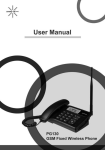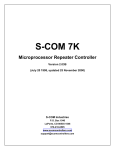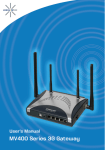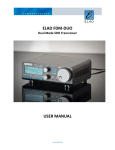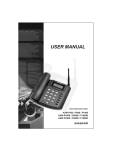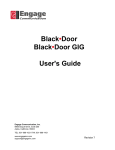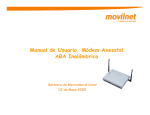Download User Manual - MobileNation
Transcript
1
INTRODUCTION
OVERVIEW
The Axesstel TX240G is a dual-band (800/1900Mhz) fixed wireless voice terminal that is perfect for a
seamless land-line like service. TX240G is designed to provide a simple phone service at a home or
business. Its Assisted GPS feature provides E911 service to accurately determine the location of the
caller in case of an emergency. Axesstel’s TX240G allows the users to migrate from landline to
wireless without losing any functionality of their regular home phone service.
FEATURES
-
CDMA2000 1x voice services (backward compatible to IS-95 A/B)
-
800/1900 MHz Dual Band
-
A-GPS for E911 location service (SMA Antenna Connector)
-
TTY/TDD Telephone Support
-
3 multi-colored LED Indicators (Signal, Mode and Power)
-
2 RJ-11 Bridged Ports (with max 3 REN)
-
Dial-Tone and DTMF Generation
-
Desktop and Wall-Mountable
-
Call Waiting, Three-way Calling and Call Forwarding
-
Call Restriction
-
Type II Caller ID (or Call Waiting Caller ID)
-
OTA(IS-683A)
2
TABLE OF CONTENTS
INTRODUCTION.......................................2
Using # as Send Key………….…………19
Overview...................................................2
Setting DTMF Length............................19
Features....................................................2
SECURITY
Safety Precautions..................................4
Changing Lock Code….........................20
Package Content………….......................5
Restricting Outgoing Calls….................20
Factory Reset…….……….....................21
BASIC INSTALLATION
TTY/TDD
Internal Battery Installation......................6
Mode Setting…….……….....................21
Setting Up the Terminal...........................6
Wall Jack Tester……...............................7
OPTIONAL FEATURES
RJ11 Cross Adaptor.................................8
Call Waiting…………….........................23
A-GPS for E911…...................................9
Three-Way Calling……….….................23
Wall Mount Installation...........................10
Voice Mail Service..………....................23
LED Indicators........................................11
MISCELLANEOUS
Audible Indicators……............................12
Menu Option Table...............................26
BASIC OPERATION
Troubleshooting.....................................27
Power On/Off…………..........................14
Specification..........................................28
Making Calls…………...........................14
Receiving Calls.....................................15
ADVANCED FEATURES
SOUND
Adjusting Voice Volume……………...….17
Adjusting Alert Tone Volume.................17
Setting One Minute Volume..................17
Setting Voice Privacy Alert....................17
Setting Connection Alert……….............18
GENERAL
Setting Caller ID and Call Waiting ID.....18
Setting Auto Send Time…………….……18
3
SAFETY PRECAUTIONS
1. Avoid placing the terminal in a dusty location, or near a source of gas or fire.
2. Do not shake, hit or drop the terminal.
3. To clean the outside of the terminal, use only a soft, dry cloth, as chemicals such as alcohol,
benzene or acetone can damage the surface of the terminal.
4. Do not twist or pull the cables.
5. Do not disassemble the terminal.
6. Do not use the power adapter if:
- The power cord is damaged.
- The adapter has been damaged in any way.
7. Use only the AXESSTEL provided power adapter. Do not use the AXESSTEL power adapter for
any other purposes.
8. Use only the AXESSTEL provided antenna. Do not use the antenna for any other purposes.
9. Frequency and length of use can affect the life of the self-charging battery. Contact your point of
sale’s customer service department if the battery is not operating properly.
10. Use only the designated self-charging battery. Dispose of exhausted batteries properly.
Never discard a battery in or near a fire or flame.
11. Do not use the terminal near water, for example, near a bathtub, sink, wet basement, or swimming
..pool.
NOTE: The input voltage and the shape of the power plug may vary from country to country.
NOTE: Use wired or cordless telephones compatible to FCC part 68 only. Non-compliant
telephones may not work properly.
4
PACKAGE CONTENTS
After opening the package, check to make sure that you have all the parts shown below.
If any item is missing or broken, please call your service provider’s support center.
①
②
Axesstel 1x Fixed Wireless Terminal
CDMA Dipole Antenna
③
Power Adapter (Input: AC100-240V, 50/60Hz / Output:5V/2A)
④
Backup Battery
⑤
User Manual and Quick Guide
⑥
GPS Antenna with Cable and Pad
⑦
RJ-11 Phone Cord
⑧
PSTN Tester
⑨
RJ-11 Cross Adaptor
⑩
Desktop Stand
CAUTION
Use the provided power adapter only. Using other power adapter may cause
permanent damage to the terminal.
5
BASIC INSTALLATION
INTERNAL BATTERY INSTALLATION
This TX240G operates by receiving electricity from an electrical outlet or internal battery.
1. Open the battery cover on the bottom side of the terminal.
2. Connect the Battery power cable to the terminal.
3. Insert the battery pack in the right position between the hold bars.
4. Close the battery cover.
SETTING UP THE TERMINAL
1. Connect the antenna by screwing it into
the TNC connector on the back of the terminal.
2. Connect a wired or cordless telephone to the
terminal using the RJ-11 phone cord.
NOTE: Use wired or cordless telephones compatible to FCC part 68 only. Non-compliant
telephones may not work properly.
3. Plug the AC adapter plug into the DC 5V jack of the Terminal.
4. Plug the AC adapter plug into an appropriate electrical outlet.
6
Connecting the Terminal to Home Phone Wall Outlet.
The TX240 can be connected to a home wall phone jack to generate a dial tone service throughout
the entire home and allow users to use phones from any other home wall phone jack.
Please verify
that the home wall phone jacks do not have existing active telephone service and that they are not
powered. Before connecting the terminal to home wall jack, please test with the included “Wall Jack
Tester”.
WALL JACK TESTER (PSTN Line Tester)
The wall jack tester will verify if the wall phone jack is powered by existing or previous landline phone
service.
IMPORTANT NOTE
DO NOT CONNECT YOUR TERMINAL TO A WALL JACK IF PSTN LINE IS STILL IN SERVICE.
Connecting the terminal to the live wall jack may interfere with the existing phone service
and damage the terminal.
1. Plug the tester into the wall jack.
2. If tester’s Green colored LED illuminates (ON), your PSTN line is still active and powered. In this
case, contact your existing or previous landline phone service provider to disconnect the phone
service and power.
NOTE: Alternately, 2-line cross adapter may be used to bypass the powered first phone line. Please
.see next section, using 2-line cross adapter.
3. If Green colored LED does not illuminate, the wall phone jack is not powered and you can safely
connect your terminal to wall jack.
[LED OFF – line is safe to use]
7
RJ-11 CROSS ADAPTOR (Line 1 to Line 2 Bypass Adapter)
If the first line of the phone line is live and has power, you may still be able to use the terminal through
your home phone wiring by using the RJ-11 cross adapter. Line 1 uses the middle two pins on the RJ11 cable. Line 2 uses the outer two pins on the RJ-11 connector.
IMPORTANT NOTE
Some house wirings may only have line 1. Some houses may have both line 1 and line 2
wires live. In such cases, please do not connect the terminal to your house wall jack.
Instead, please consider using multi-handset cordless phone. Connect the base of the
cordless phone directly to the terminal using RJ-11 cable.
1. Before connecting the terminal, test the line 2 in your house by plugging the cross adapter into the
wall jack. Then plug the Wall Jack Tester into the back of the cross adapter. If the LED is lit, line
2 is also live.
2. If the line 2 is not live, connect one of the cross connector between the terminal and wall-jack. This
will convert the terminal output to line 2 of the in-wall wiring.
3. Connect another cross connector between another wall jack and corded/cordless phone in another
room. Check if there is dial tone or busy tone on the line.
4. If no tone is heard, please check if the terminal is turned on properly. If the problem persists, it
may be possible that the home wiring line 2 is not available.
NOTE: The default packaging may or may not include the cross adaptors. Cross adapter may be
called a “2-Line Splitter” and should be readily available at local electronic or office supply
stores.
8
A-GPS for E911
Your terminal supports an A-GPS feature to meet a FCC 911 mandate, which makes the location of
the terminal available to 911 operators in the case of emergency situations. During the emergency call,
all the LEDs on the terminal will blink and your location can then be determined by the 911 operator. In
order to increase the location accuracy, the external GPS antenna must be connected to the terminal
and positioned at a location that can receive satellite signals, such as outside the home or building or
near a window without obstructions to the sky.
IMPORTANT NOTE
The accuracy of the A-GPS location will significantly degrade if the A-GPS antenna is not
connected to properly or located indoor or at a place with obstruction to the sky. In such
cases, the emergency dispatcher will not be able to accurately locate your position. The AGPS signal and location accuracy can be dependent on many factors and cannot be
guaranteed.
1. Connect the A-GPS antenna to the SMA
connector on the terminal.
2. Place the Magnetic Pad at a location that
has no obstruction to the sky, such as
outdoors or near a window.
3. Put the A-GPS antenna on the magnetic pad
and position the antenna to face outside.
9
WALL MOUNT INSTALLATION
1. Mark two mounting hole locations on a wall to match the screw holes on the back of the terminal.
2. Drill two holes and put screws at the marked locations.
3. Tighten the screws until the head is about 5mm from the wall.
4. Plug in the AC power connector and route the power cord in the groove, if needed. Connect
antenna.
5. Hang the terminal on the screws using the two holes on the back.
6. Push the terminal down until the unit is firmly locked into place.
10
GETTING TO KNOW THE TERMINAL
LED INDICATORS
Item
Color
Status
Description
In Battery Mode: Fully Charged Full
POWER
Solid
In Adaptor Mode: Connected
Green
Blinking
Charging
Solid
Mid Battery Level
Orange
Blinking
Battery Error
Solid
Low Battery
Red
Blinking
SIGNAL
MODE/MSG
Low Battery Warning
Off
-
No Battery
Green
Solid
Excellent Signal
Orange
Solid
Good Signal
Red
Solid
Low Signal
OFF
-
No Service
Solid
Off-Hook or In Use
Green
Blinking
Incoming Call
Orange
Blinking
Voice Mail Waiting
All LEDs
Blinking
All LEDs blink during emergency call
E911 Call
11
AUDIBLE INDICATIORS
No
Tone
Cadence
Remark
1
Dial Tone
Continuous beep
330ms ON / OFF
660ms ON / OFF
Terminal is in service area and
can make calls.
2
Busy Tone
Beep - beep - beep
0.5s ON / 0.5s OFF
Recipient line is busy
3
Howler Tone
4
No Service Tone
5
Function Confirm Tone
Escalating bee – bee -beep
1046Hz: 350ms ON
1328Hz: 350ms ON
1567Hz: 350ms ON
Used when accessing menu.
Menu selection or configuration
successful
6
Function Error Tone
Three Short Beeps
Used when using menu.
Menu selection or configuration
not successful
7
Outgoing Call
Restriction Tone
800ms ON
200ms OFF
Terminal is configured to block
outgoing call (incoming calls are
permitted)
8
Voice Mail Indicate Tone
0.1s ON
0.1s OFF(One Time)
9
One Minute Alert Tone
Short beep
0.1s(One Time)
High pitched beep
(1400+2060Hz) 0.1S ON
(2450+2600Hz) 0.1S OFF
Long beep + pause
1.5s ON
800ms OFF
12
Phone receiver is off the hook for
more than specified duration
Terminal cannot make or receive
calls (No signal)
Basic Operation
POWER ON/OFF
MAKING CALLS
RECEIVING CALLS
13
POWER ON / OFF
The power switch is located on the back side of the terminal
1. Turn on the unit by moving switch to ON position.
2. Turn off the unit by moving switch to OFF position.
NOTE: When you turn on the terminal, it automatically searches for cellular service.
After successfully acquiring cellular service, the Signal LED turns to Green, Orange or Red
depending on signal strength.
MAKING CALLS
1. Check if the terminal is turned on.
2. Pick up the handset of the phone.
3. If you hear a dial tone, dial the desired telephone number by using the wired or cordless
telephone’s keypad.
NOTE: You can dial a phone number with a maximum of 32 digits, including □
* and □
#.
4. Wait for about 3 seconds until the call is automatically processed by the terminal. (Auto Dial Time
can be configured from 3 seconds to 9 seconds, or turned-off).
NOTE: If “□
# as Send Key” feature is enabled, press the □
# button to process the call
immediately after entering the dialed number. Default setting is OFF. Please refer to the
page 19 for “Using □
# as Send Key”.
5. When the other recipient answers, begin conversation.
NOTE: If Connection Alert is turned on, a beep is heard when the call is connected. The default
setting is OFF.
6. To hang up, put the phone receiver back on the phone hook or press the TALK or OFF button on
your phone.
14
RECEIVING CALLS
The wired or cordless telephone(s) connected to the terminal ring when an incoming call
comes in.
1. Pick up the phone receiver to answer the call.
2. To disconnect after the call is finished, place the handset on the phone hook or press the TALK or
OFF button on your phone.
NOTE 1: If using cordless phone, press TALK or ON button to answer the phone call.
.Refer to the cordless phone user manual for instruction.
NOTE 2: Make sure that the attached telephone(s) ringers are enabled.
NOTE 3: When there is another incoming call during an already active phone call, press any
.key on the numeric keypad to answer the call.
15
Advanced Features
SOUND
○
○
○
○
○
ADJUSTING VOICE VOLUME
ADJUSTING ALERT TONE VOLUME
SETTING ONE MINUTE ALERT
SETTING VOICE PRIVACY ALERT
SETTING CONNECTION ALERT
.GENERAL
○ SETTING CALLER ID
○ CALL WAITING ID
○ CALLER NAME DISPLAY
○ SETTING AUTO SEND TIME
○ USING # AS SEND KEY
○ SETTING DTMF LENGTH
.SECURITY
○ CHANGING LOCK CODE
○ RESTRICTING OUTGOING CALLS
○ FACTORY RESET
.TTY/TDD
○ MODE SETTING
16
SOUND
ADJUSTING VOICE VOLUME
You can control the volume level of the terminal.
1. Pick up the handset and listen to the dial-tone.
* □
* □
1□
1□
* to raise the voice volume.
2. Press □
* □
* □
1□
1□
# to lower the voice volume.
3. Press □
4. A confirmation beep will sound.
NOTE 1: Some phones may have their own volume control. Use both the terminal and the phone
.volume controls to optimize the sound level.
NOTE 2: Volume cannot be adjusted while a conversation is in progress.
ADJUSTING ALERT TONE VOLUME
1. Pick up the handset.
* □
* □
1□
2□
* to raise the alert tone volume.
2. Press □
* □
* □
1□
2□
# to lower the alert tone volume.
3. Press □
SETTING ONE MINUTE ALERT
When this feature is enabled, a discrete tone is generated at each one minute interval on the
receiver during a conversation for both incoming and outgoing calls. This tone is to help the
user keep track of the phone usage.
To change the setting:
1. Pick up the handset.
* □
* □
1□
3□
# to enable the feature.
2. Press □
* □
* □
1□
3□
* to disable the feature.
3. Press □
SETTING VOICE PRIVACY ALERT
If enabled, a beep is generated when Voice Privacy is on.
To change the setting:
1. Pick up the handset.
* □
* □
1□
4□
# to enable the feature.
2. Press □
* □
* □
1□
4□
* to disable the feature.
3. Press □
17
SETTING CONNECTION ALERT
If enabled, a discrete tone is generated on the receiver when a call is connected.
To change the setting:
1. Pick up the handset.
* □
* □
1□
5□
# to enable the feature.
2. Press □
* □
* □
1□
5□
* to disable the feature.
3. Press □
NOTE: The default setting may depend on the service provider.
GENERAL
SETTING CALLER ID MODE
If your phone connected to the terminal is caller ID enabled, you can set the terminal to display
the caller identification number or name on the LCD display of the wired or cordless phone.
To change the setting:
1. Pick up the handset.
* □
* □
2□
1□
0□
# to disable the Caller ID feature.
2. Press □
* □
* □
2□
1□
1□
# to enable DTMF Standard type.
3. Press □
* □
* □
2□
1□
2□
# to enable FSK (Bellcore) type.
4. Press □
NOTE: The default setting of Caller ID is FSK.
CALL WAITING ID
The Call Waiting ID feature allows the display of the second caller’s number while already in a
conversation (call waiting). This feature works only with FSK Caller ID setting.
In order to use this
feature, the corded/cordless phone must support caller ID and call waiting ID, also known as type II
caller identification.
CALLER NAME DISPLAY
This feature allows the display of the caller’s name on the corded or cordless phones that support
alpha-numeric display for caller name display.
This is a network dependent feature and works only if
your service provider supports it. This feature may require an upgrade to premium service or an
additional fee.
18
SETTING AUTOSEND TIME
Similar to a landline phone, the terminal automatically makes the call shortly after the user
finishes entering the phone number. To change the setting:
1. Pick up the handset.
* □
* □
2□
2 Then press □
3 ,□
9 or □
0 and press □
#.
2. Press □
* □
* □
2□
2□
5□
#.
For example, to set the auto-send time to 5 seconds, press □
NOTE 1: 0 value disables auto-send. If disabled, the user must press □
# to make a call. □
#
functions as a SEND key on the mobile phone.
#
□
If auto-send time is set to 0,
then the
as SEND feature is automatically enabled.
NOTE 2: The default auto send time is 3 seconds.
USING □
# AS SEND KEY
Similar to mobile phones, pressing the □
# key after entering the phone number can act as SEND
key.
This feature can be enabled or disabled. To change the setting:
1. Pick up the handset.
* □
* □
2□
3□
# to enable the feature.
2. Press □
* □
* □
2□
3□
* to disable the feature.
3. Press □
Note: The default setting is OFF.
If the Auto-Send Time is set as 0, then “□
# as SEND key”
feature is automatically enabled.
SETTING DTMF LENGTH
Some ARS (Automatic Response Service) require short or long DTMF tones depending on the
system. To change the setting:
1. Pick up the handset.
* □
* □
2□
4□
# to select Short DTMF tone.
2. Press □
3. Press □
* □
* □
2□
4□
* to select Long DTMF tone.
19
SECURITY
CHANGING LOCK CODE
The lock code prevents the terminal from being used by an unauthorized person without
0□
0□
0□
0.
permission. The default lock code is □
To change the lock code:
1. Pick up the handset.
* □
* □
3□
1.
2. Press □
0□
0□
0□
0 , a short beep will sound as confirmation. If
3. Enter the old 4 digit lock code. For example □
not correct, an error tone will sound and the terminal will return to standby mode.
4. Enter the new 4 digit lock code followed by □
# . For example □
1□
2□
3□
4□
# , another short beep
will sound as confirmation.
5. Re-enter the new 4 digit lock code followed by □
# . For example □
1□
2□
3□
4□
# , another beep will
sound as confirmation. If not correct, error tone will sound and the terminal will return to standby
mode.
For example, to change the lock code from □
0□
0□
0□
0 to □
1□
2□
3□
4 , press
* □
* □
3□
1 □
0□
0□
0□
0 □
1□
2□
3□
4□
# □
1□
2□
3□
4□
#.
□
RESTRICTING OUTGOING CALLS
This feature can be used to block outgoing calls from being made. But incoming call can still
be received. To change the setting:
1. Pick up the handset.
* □
* □
3□
2.
2. Press □
3. Enter 4 digit lock code.
# to enable or □
* to disable.
4. Press □
NOTE 1: The default lock code is □
0□
0□
0□
0 . To change, refer to “Changing Lock Code” section.
NOTE 2: If someone tries to make a call when outgoing call restriction is enabled, the terminal
sounds a beep and howler tone.
20
FACTORY RESET
Reset the user configuration to factory default settings.
1. Pick up the handset.
* □
* □
3□
5.
2. Press □
3. Enter the 4 digit lock code. If not correct, an error tone will sound and the terminal will return to
standby mode.
# to reset.
4. Press □
NOTE 1: The default lock code is □
0□
0□
0□
0 . To change, refer to “Changing Lock Code” section.
NOTE 2: Factory reset includes auto send time, lock code, call restrictions, caller ID type, voice
.privacy alert, connection alert and 1 minute alert.
TTY/TDD
MODE SETTING
To use the TTY/TDD feature, refer to following instruction. The default setting is OFF.
1. Connect the TTY/TDD phone to the terminal through the RJ-11 jack.
2. Pick up the handset.
* □
* □
4□
1□
0□
# for TTY Full Mode.
3. Press □
* □
* □
4□
1□
1□
# for TTY Talk Mode.
4. Press □
5. Press □
* □
* □
4□
1□
2□
# for TTY Hear Mode.
* □
* □
4□
1□
3□
# for Off.
6. Press □
NOTE 1: For the detailed instructions, contact your service provider.
NOTE 2: Some TTY device may not generate the DTMF tone for * and #, which is necessary to
change the TTY/TDD mode. In such case, please use regular analog phone to enter the
mode change key sequence.
21
Optional Features
CALL WAITING
THREE-WAY CALLING
VOICE MAIL SERVICE
22
CALL WAITING
Call Waiting is a feature which enables you to be alerted to a second incoming call when you
are already on a phone call. Your service provider may or may not provide this feature. Please
contact with your service provider to inquire. To use call waiting:
1. You will hear a beep from the earpiece when a second call is incoming.
2. Press the hook or press the FLASH key to answer to the second call.
3. Press the hook again or press the FLASH key to return to the first call.
THREE-WAY CALLING
Three-Way Calling is a feature that enables you to set up a three-way conversation with two
other callers. Your service provider may or may not provide this feature. Please contact with
your service provider to inquire. To use three-way calling:
1. Place a call.
2. Place a second call then press hook/flash key.
3. When the second call is answered, press the hook or press the FLASH key to start a three-way
call.
Optional 3-way calling procedure (Network Dependent)
1. Place a call.
2. Press Hook/Flash
3. Dial the second number.
4. Press Hook/Flash (This initiates the second call).
5. Wait for the second call to be connected (Answered).
6. Press Hook/Flash again to merge the calls.
VOICE MAIL SERVICE
When you receive voice message(s), the MODE/MSG LED will blink orange in color on the
terminal. When you lift the receiver, a stuttered voice message tone will be heard. Once your
voice messages are checked and deleted, the LED turns off and the shuttered dial tone will
return to a steady tone after few seconds. The Voice mail feature may not be part of your
service, so please check with your service provider.
23
Accessing your Voice Mail service
Please check with your service provider for the voice mail access number.
1. Dial the voice mail access number as normal phone number.
2. Follow the voice instruction to listen and delete the messages.
NOTE: Initially, you may need to set-up voice mail.
voice mail service.
24
Follow the voice instructions to set-up the
Miscellaneous
MENU OPTION TABLE
TROUBLESHOOTING
SPECIFICATION
25
MENU OPTION TABLE
Access the menu by first lifting the handset or pressing the TALK button and their pressing ** followed
by the appropriate number sequence as shown below.
MENU
("**○○")
Sub Menu ITEM
1. Adjusting Voice
Volume
2. Adjusting Alert
Volume
1.Sound
3. Setting 1 Minute
Alert
4. Voice Privacy
Alert
5. Connection
Alert
1. Setting Caller ID
2. General
2. Setting Auto Send
time
# as Send key
3. □
4. Setting DTMF Length
1. Changing Lock code
3. Security
4.TTY
*
□
#
□
*
□
#
□
*
□
#
□
*
□
#
□
*
□
#
□
0
□
1
□
2
□
EXAMPLE
Louder
Lower
Louder
Lower
Off
On
Off
On
Off
On
No Caller ID
DTMF Standard
FSK (Bellcore):Default
3~9 seconds
0 OFF
□
*
□
#
□
*
□
#
□
Off
On
Long
Short
Old lock code,(Tone),
#,
New lock code,□
#
New lock code again □
Lock code +
* □
* □
1□
1□
* (louder)
□
* □
* □
1□
1□
# (lower)
□
* □
* □
1□
2□
* (louder)
□
* □
* □
1□
2□
# (lower)
□
* □
* □
1□
3□
* (off)
□
* □
* □
1□
3□
# (on)
□
* □
* □
1□
4□
* (off)
□
* □
* □
1□
4□
# (on)
□
* □
* □
1□
5□
* (off)
□
* □
* □
1□
5□
# (on)
□
* □
* □
2□
1□
0□
# (No caller id)
□
* □
* □
2□
1□
1□
# (DTMF)
□
* □
* □
2□
1□
2□
# (FSK)
□
* □
* □
2□
2□
3□
# (3 seconds)
□
* □
* □
2□
2□
0□
# (off)
□
* □
* □
2□
3□
* (off)
□
* □
* □
2□
3□
# (on)
□
* □
* □
2□
4□
* (Long)
□
* □
* □
2□
4□
# (Short)
□
0□
0□
0□
0 to□
1□
2□
3□
4
To change from □
* □
* □
3□
1□
0□
0□
0□
0 (confirm tone)
□
1□
2□
3□
4□
# □
1□
2□
3□
4□
#
□
0□
0□
0□
0 , press
If lock code is □
* □
* □
3□
2□
0□
0□
0□
0□
* (off)
□
* □
* □
3□
2□
0□
0□
0□
0□
# (on)
□
2. Restricting
Outgoing Calls
* Off or □
# On
□
3. Factory Reset
#
Lock code, □
0□
0□
0□
0:
If lock code is □
* □
* □
3□
5□
0□
0□
0□
0□
#
□
1. TTY Mode Set
0
□
1
□
2
□
3
□
* □
* □
4□
1□
0□
# : TTY FULL
□
* □
* □
4□
1□
1□
# : TTY TALK
□
* □
* □
4□
1□
2□
# : TTY HEAR
□
* □
* □
4□
1□
3□
# : TTY Off
□
TTY FULL
TTY TALK
TTY HEAR
TTY OFF (Default)
Three escalating beeps (bee-bee-beep) indicate a successful entry.
Three short beeps (beep-beep-beep) indicate an unsuccessful entry.
26
TROUBLESHOOTING
Problem: I Can’t Place a Call
1. Check the Terminal’s Power LED to make sure the Terminal is ON.
2. Check the antenna to make sure it is tightly connected to the Terminal.
3. Check the phone cord to make sure it is properly connected between the Terminal’s RJ-11 port and
the Telephone’s RJ-11 port.
4. In case that the telephone isn’t functioning properly, try connecting the Terminal to a different
telephone.
5. If you perform all of the above steps and still can’t make a call, contact your service provider.
Problem: I Can’t Receive a Call
1. Check the handset to make sure it is placed properly on the cradle.
2. Check the Terminal’s Power LED to make sure the Terminal is ON.
3. Check the antenna to make sure it is tightly connected to the Terminal.
4. If you perform all of the above steps and still can’t receive a call, contact your service provider.
Problem: No Power
1. Make sure the power adapter (or External Power Supply) is securely connected between the
electrical outlet and the Terminal.
2. Make sure a back-up battery is properly connected to the Terminal. (Refer to BASIC INSTALLATION
section, Page 6)
3. When using in battery-only mode, make sure the back-up battery is fully charged. To view the
charge level, check the Terminal’s power LED. (Refer to LED INDICATORS section, Page 11)
4. Make sure the power switch is in the ON position. The power switch is located on the back side of
the Terminal.
Problem: No Signal
If you don’t hear any dial tone through the handset and RSSI (Received Signal Strength Indication)
LED is OFF,
1. Check the Terminal’s Power LED to make sure it is ON.
2. Make sure your telephone is operational.
3. Make sure the antenna is tightly connected to the Terminal.
If the Terminal is powered on and the antenna is properly connected to the Terminal but you still don’t
hear a dial tone or see a light on the RSSI LED, contact your service provider.
27
SPECIFICATIONS
Item
Description
Remark
Air Interface
CDMA2000 1X
RF Frequency
800MHz/1900Mhz
Dual band
LED Indicator
- 3 multi color
- POWER, SIGNAL and MODE/MSG
Green, Orange, Red, Off
Interface
- 2 RJ-11 Ports (bridged), Max 3 REN
- DC power Jack
- Power ON/OFF Switch
- TNC Connector for CDMA antenna
- SMA Connector for A-GPS antenna
Battery
- Li-ion rechargeable battery
- Capacity :1000mAh (Standard)
* Stand by time: 7Hrs
* Talk time:1Hr
Power Adapter
- Input: AC100-240V, 50/60Hz
- Output:5V/ 2A
Dimension
- Size: 165 X 117.5 X 31 (mm)
- Weight: 268g
Operating
Condition
- Temperature: -10℃ ~ 50℃
- Relative humidity : 10~95%
With standard battery
AXT STD V 1.1
AXESSTEL INC.
6815 Flanders Drive Ste. 210
San Diego, CA 92121, USA
www.axesstel.com
© Axesstel Inc, All Rights Reserved
28
29






























